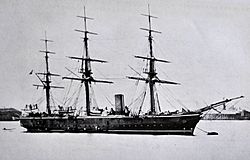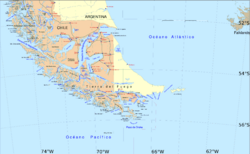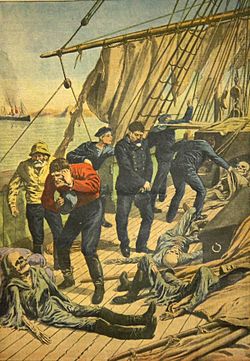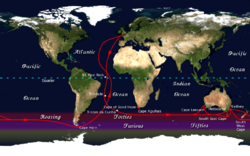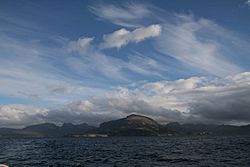Marlborough (1876 ship) facts for kids
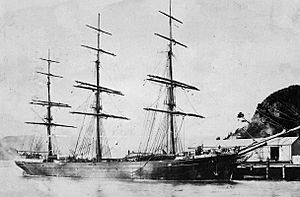
The Marlborough in Port Chalmers (NZ)
|
|
Quick facts for kids History |
|
|---|---|
| United Kingdom | |
| Name | Marlborough |
| Owner | John Leslie, 79 Mark Lane, London |
| Builder | Robert Duncan and Co., Port Glasgow |
| Yard number | 73,858 |
| Launched | June 1876 |
| Homeport | Glasgow |
| Fate | Last sighted 13 January 1890, near New Zealand |
| General characteristics | |
| Type | Full-rigged ship |
| Tonnage | 1191 gross, 1124 net |
| Length | 228 ft (69 m) |
| Beam | 35 ft (11 m) |
| Draught | 21 ft 7 in (6.58 m) |
| Sail plan | Three-masted full-rigged ship |
| Crew | 29 |
The Marlborough was a large sailing ship made of iron. It had two decks and carried goods for trade. Built in Port Glasgow in 1876, it was owned by John Leslie before being sold to the Albion Line. In January 1890, the Marlborough vanished during a journey. No one has seen or heard from the ship in over 100 years. Even after many searches, its final fate and what happened to its crew remain a mystery.
Contents
Early Journeys and Cargo
From 1876 to 1883, Captain Anderson commanded the Marlborough. The ship had a crew of 29 people. It often sailed to Lyttelton, New Zealand and Dunedin. The Marlborough was known for its fast trips back to the United Kingdom. In 1880, it traveled from Lyttelton to the Lizard in Cornwall in just 71 days.
The Marlborough completed 14 successful trips. It carried immigrants from London to New Zealand until 1890. On its return journeys, it usually carried wool and frozen meat. The ship was changed to carry refrigerated goods after its sister ship, the Dunedin, proved this was a good idea. The Marlborough carried its first refrigerated cargo in 1882. In 1884, Captain Herd took over command. He was the captain when the ship disappeared in 1890.
The Final Voyage
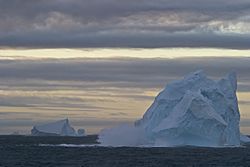
On January 11, 1890, the Marlborough left Lyttelton, New Zealand. It was heading for London. The ship carried frozen meat and wool. There were 29 crew members and one female passenger, Mrs. W. B. Anderson, on board. Two days later, Captain Gordon of The Falkland Hill spoke to the Marlborough. After this, no one ever heard from the ship again.
When the ship did not arrive, an investigation began. It was confirmed that the cargo was packed correctly. The ship was in good condition for the journey. After several months, the Marlborough was listed as "missing" by Lloyd's Register. Many people believed the ship had sunk because of icebergs. Icebergs were common near Cape Horn.
Another ship, the RMS Rimutaka, reported seeing many icebergs. This was in the Southern Ocean between Chatham Island and Cape Horn. The Rimutaka sailed through this area in early to mid-February. This was around the same time the Marlborough would have been there. Captain Herd of the Marlborough was known for sailing far south. The shortest route between Lyttelton and Cape Horn goes close to the Antarctic Circle. It can go as far south as 68 degrees.
Large Antarctic icebergs have been seen as far north as 50 degrees south in the Pacific Ocean. This area is within the old sailing routes. Cape Horn is located at 56 degrees south.
A ship's apprentice named Alex Carson was supposed to sail on the Marlborough's last trip. However, he became ill before the ship left. His illness saved his life.
Search by HMS Garnet
In mid-1891, a search was launched for the crews of the Marlborough and Dunedin. HMS Garnet, an Emerald-class corvette from the Pacific Squadron, led the search. This happened because of a rumor. The rumor said that crew members were seen near Good Success Bay, Tierra del Fuego.
The story first appeared in The Daily Colonist newspaper in Victoria, British Columbia. It was published on April 9, 1891. The story claimed that a sealing schooner called Maud S had met some shipwrecked British sailors. This happened in January 1891. These sailors were supposedly forced to work by the Argentine government at a life-saving station in Good Success Bay. The Garnet searched the bay and the area around it. No sailors were found, and there was no proof of their existence.
Stories About the Ship's Fate
Two main stories are often told about the Marlborough's fate. However, the author Basil Lubbock has shown them to be incorrect in his book The Last of the Windjammers. These stories are the "Ghost Ship" and the "Burley account." The ghost ship story is believed to be made up. The Burley account is thought to be a case of mistaken identity.
The Ghost Ship Story
In October 1913, a newspaper in Singapore, The Straits Times, published a strange story. It claimed the Marlborough had been found near Cape Horn. The ship supposedly had skeletons of its crew on board, which were "slimy to the touch." The Straits Times said the story came from the London paper, the Evening Standard, on October 3, 1913. The Evening Standard mentioned that the story was based on a report from New Zealand that needed to be checked. The sailing ship Johnson was said to have seen the Marlborough in 1913. This sighting supposedly happened about eight weeks before the newspaper article. This would mean the ship was found in late July or early August 1913.
Further details of the discovery of the missing ship come via London. It appears that some considerable time back the sad truth was learned by a British vessel bound home from Lyttleton after rounding Cape Horn. The story told by the captain is intensely dramatic. He says: 'We were off the rocky coves near Punta Arenas, keeping near the land for shelter. The coves are deep and silent, the sailing is difficult and dangerous. It was a weirdly wild evening, with the red orb of the sun setting on the horizon. The stillness was uncanny. There was a shining green light reflected on the jagged rocks on our right. We rounded a point into a deep cleft rock. Before us, a mile or more across the water, stood a vessel, with the barest shreds of canvas fluttering in the breeze.
We signaled and hove to. No answer came. We searched the "stranger" with our glasses. Not a soul could we see; not a movement of any sort. Masts and yards were picked out in green – the green of decay. The vessel lay as if in a cradle. It recalled the "Frozen Pirate" a novel that I read years ago. I conjured up the vessel of the novel, with her rakish masts and the outline of her six small cannon traced with snow. At last we came up. There was no sign of life on board. After an interval our first mate, with a number of the crew, boarded her. The sight that met their gaze was thrilling. Below the wheel lay the skeleton of a man. Treading warily on the rotten decks, which cracked and broke in places as they walked, they encountered three skeletons in the hatchway. In the mess-room were the remains of ten bodies, and six others were found, one alone, possibly the captain, on the bridge. There was an uncanny stillness around, and a dank smell of mold, which made the flesh creep. A few remnants of books were discovered in the captain's cabin, and a rusty cutlass. Nothing more weird in the history of the sea can ever have been seen. The first mate examined the still faint letters on the bow and after much trouble read 'Marlborough, Glasgow.'
– Newspaper report, 1913
There are many reasons why this story is unlikely:
- The area around Cape Horn has strong storms, powerful currents, and icebergs. A drifting ship would likely crash into rocks or ice, not float gently for over 20 years.
- Cape Horn was a very busy shipping route. It is unlikely a ship would remain hidden for so long. The Panama Canal did not open until 1914. This was the fastest route for ships from the American Pacific Coast to the Atlantic.
- Punta Arenas was a large town. A small gold rush also started there in the 1890s. This makes it even less likely the ship would go unnoticed.
- The area around Cape Horn was often searched for missing ships. Many shipping disasters happened there.
- Sailing ships like the Johnson would not normally use this route to reach New Zealand. The usual route from England was the Clipper route around the Cape of Good Hope.
- The Johnson was not listed as being in a New Zealand port between 1912 and 1913.
- No record of a sailing ship named Johnson in 1913 has been found.
- If such an event happened, New Zealand newspapers would have reported it widely.
- The newspapers that reported the finding did not publish any follow-up stories.
- New Zealand newspapers in 1914 thought the story was untrue.
- No follow-up search for the Marlborough happened, which would be expected.
- The Marlborough did not have a bridge.
Other Ghost Ship Versions
1929 Version
Another version of this story came out in 1929. In this tale, the Marlborough was found drifting in January 1899. The ship British Isles, commanded by Captain Hadrop, supposedly found it. The British Isles was said to be sailing from Lyttelton to England. It was a little north of Cape Horn near Staten Island when the Marlborough was seen. This story was also doubted. There were no reports of the British Isles visiting Lyttelton at that time. Also, it was unlikely Captain Hadrop would wait so many years to report the sighting.
The British Isles was a 2394-ton iron sailing ship built in 1884. It was owned by the British Shipowners Company. In 1899, it was sold to Thomas Shute. In August 1898, the British Isles was in San Francisco. It sailed from there to England around Cape Horn with a load of wheat. The ship's captain on this trip was James M. Stott. This means the ship was in the area around the claimed time. However, it does not explain why the sighting was not reported. Also, it had the wrong captain. There is no record of Hadrop ever being a captain of the British Isles or sailing from a port it did not visit.
2006 Version
In 2006, Tom Quinn published another version in a book. In this story, a British Royal Navy ship found the Marlborough off the coast of Chile in 1913. Neither the naval ship nor its captain were named. The source of the information was also not given. Given how much interest there was in the Marlborough in 1913 newspapers, it is very unlikely Quinn's claim is true. Such a sighting would have been widely reported.
The Burley Account
The ghost ship story may have come from an imaginative tale based on Captain Thomas Sydney Burley's 1912 account. This account had been shared in England. In September 1913, the Evening Post, a newspaper in Wellington, New Zealand, published a story. It was said to be from Captain McArthur of the Blue Funnel Steamers. The story was in a letter from a Shaw, Savill & Albion Line captain to a shipping man in Dunedin. This account was different. It said that two shipwrecked sailors found the skeletons of the crew on shore. The ship was some distance away.
This story was supposedly disproven by October. Captain Herd's son said the story had been around since 1912 and was false. He especially noted that his father would not have sailed through Le Maire Strait, where the ship was supposedly found. Ships usually avoided this Strait because it was considered dangerous.
In February 1914, the Evening Post published a follow-up article. It said that Captain Thomas Sydney Burley of Puget Sound was one of the crew members who found the boat. They had been shipwrecked in the 1890s, not 1912. Burley owned the Tacoma Barge and Tug Company. He was also a pilot for Blue Funnel Steamers when the 1914 article was published. The paper said the wreck was seen six to seven miles north of Good Success Bay. It was also visible (on a clear day) from Staten Island. The article also had Burley saying the ship was "a London ship, the Marlborough." However, the ship was actually registered in Glasgow. Herd's comment about his father not sailing in this part of Cape Horn was also addressed.
According to an article in the November 24, 1923, issue of the Auckland Star, another report was published in 1919. This report was in an unnamed Glasgow newspaper. It suggested that the crew had been seen on shore in 1891. But the passing ship could not rescue them. This seems to be partly from the 1891 report by the Canadian sealing schooner Maud S. The Auckland Star said the Glasgow story also repeated the first story about the ship being found in 1913 with a dead crew.
A more detailed account of Captain Burley's claim was printed in 1940. Burley claimed he was on the barque Cordova. He said it was wrecked off Tierra del Fuego on July 23, 1890. The survivors tried to reach Good Success Bay on Mitre Peninsula. On the way, they passed the wreck of a barque named Godiva. They did not see the Marlborough. However, a few miles south of the Godiva's wreck, they found a ship's boat marked "Marlborough of London." It was pulled up above the high tide mark. It was also claimed that they found a tent made from sail canvas and 7 skeletons with a pile of mussel shells.
Based on this, Burley's account seems more like a case of mistaken identity. His story matches what happened to the Cordova and the rescue of four crew members in September 1888. However, the Cordova sank around July 26, 1888. The Cordova's crew was rescued a year and a half before the Marlborough might have sailed through the area. Burley, born in England in 1871, arrived in Washington in 1890. He might have mixed up the dates since the report was over 20 years after the event. Even in 1913, Burley's account was thought to be a mistake.
Lubbock points out that the coast of Tierra del Fuego inside the Le Maire Strait would be a strange place for a ship like the Marlborough to run aground. The Marlborough was coming around Cape Horn from the west. It would also be odd for a boat from the ship to land there.
The Iquique
Another possible explanation for Burley's account is that the boat they found was from the Iquique. This was an 899-ton barque from H. Fölsch & Co., Hamburg. It went missing after being spoken to at Cape Horn on June 1, 1883. There were 30 crew members on board.
The Iquique was originally named the Marlborough when it was built in 1862. It was sold to Fölsch and renamed in 1882. The Iquique had sailed from Newcastle On Tyne in February 1883. Captain G. Eduard Jessen was in command. It carried coal for Iquique, Chile.
If any of its crew had reached Good Success Bay in 1883, they would have been in a lonely and dangerous place. The native people were not friendly, and the weather was harsh. Their only hope of rescue was if a passing ship saw them. The Argentine government only set up a settlement in Good Success Bay in late 1887. This was four years after the Iquique went missing.
Fate of Her Sister Ship – the Dunedin
The Dunedin was the Marlborough's sister ship. It sailed for London two months after the Marlborough, on March 19, 1890. The Dunedin also disappeared without a trace.


